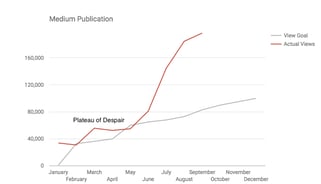Our “planet,” comprised of our website and blog, continues to fuel our company’s growth at a higher rate than any other marketing tactic. While a lot of content discovery still happens through search, more and more people are consuming articles directly from platforms like Medium, Facebook, and podcasts. Apps like Medium have become new discovery platforms for content. On the open web, people are searching, but on Medium, people come to spend time reading. We have always tried to build our content strategy by paying attention to our readers over ourselves. We decided to just get some content up on the platform and see what it did. We’ve seen our best success by finding writers on the rise on Medium and syndicating content they’ve created -- exposing both them and ourselves to a new audience. Discovering the Power of a Built-In Audience People talk a lot about the power of Medium’s built-in audience. HubSpot has been writing content for more than ten years. If Medium really is a hybrid between a social network and a publishing platform, and success is determined by how engaging your content is, it may make sense to look at how active that follower base is.

Editor’s Note: This post was originally published on Context, a publication brought to you by Medium’s Creative Strategy team. Follow the publication to keep abreast of the best ideas in brand storytelling.
Two years ago if you asked me to explain the concept of content marketing I would start by talking to you about planets.
Imagine you are a marketer standing all alone — like The Little Prince — in the middle of a small planet. That planet is your website. Today it doesn’t get many visitors because it’s too small to notice and the universe is filled with bigger, more interesting planets.
But like planets, as you build up the mass of content around you, your website grows, and your gravitational pull becomes stronger. More content, keywords, and inbound links pulls more people your way. Content becomes your magnet.
This fundamental principle of content marketing has been a key part of HubSpot’s marketing playbook. Our “planet,” comprised of our website and blog, continues to fuel our company’s growth at a higher rate than any other marketing tactic. You may find it odd then, that about a year ago, we very quietly walked to the edge of our home planet and stepped off.

Amazing space cat by William Herring
Getting Behind the Idea of Publishing Off-Site
We started ThinkGrowth.org, an off-site publication on Medium.com. November 2016 marked the one year anniversary of ThinkGrowth.org and I wanted to share a little bit about what we’ve learned: why we did it, where we stumbled, and — because benchmarks were hard to come by when we were getting started — what our numbers looked like throughout the year.
Grab your space helmets. Here we go.
Let me make this very clear: you do not own your audience. Regular monthly visitors, big subscriber lists, well-trodden conversion paths give us the illusion that we own the attention of our audience — but it is only an illusion. Attention is fleeting, and must constantly be earned.
While a lot of content discovery still happens through search, more and more people are consuming articles directly from platforms like Medium, Facebook, and podcasts. Medium has done a remarkable job with editorial curation and a loyal readership has followed, with a lot of this being driven by mobile. According to 2016 research from eMarketer, 86% of time spent on mobile devices is spent in apps rather than internet browsers. Apps like Medium have become new discovery platforms for content.
And these new discovery platforms come with notable differences in behavior. On the open web, people are searching, but on Medium, people come to spend time reading. This leads to much higher engagement on Medium and it’s this engagement, not search behavior, that fuels further discovery.
As the saying goes, sometimes you have to lose sight of your own shore to explore new lands. We have always tried to build our content strategy by paying attention to our readers over ourselves. Simply put, we decided to publish on Medium because we wanted to be where our readers are.
Breaking Through the New Publication Plateau
We’ve long admired the transparency of companies like Buffer who make a practice of openly sharing their own experiences and data. So, here’s our data from the last year. It wasn’t always pretty.

We started unassumingly on Medium. We didn’t launch with a bang or promotional push. We decided to just get some content up on the platform and see what it did. Our early posts were mostly cross-published content from the HubSpot blog (Medium makes it very easy to do this without hurting your own SEO). These first cross-posted pieces back in November of 2015 netted a few hundred views each, not too exciting.
But we quickly found that certain content just does better on Medium. As I mentioned, people come to Medium to read, not search for…
COMMENTS